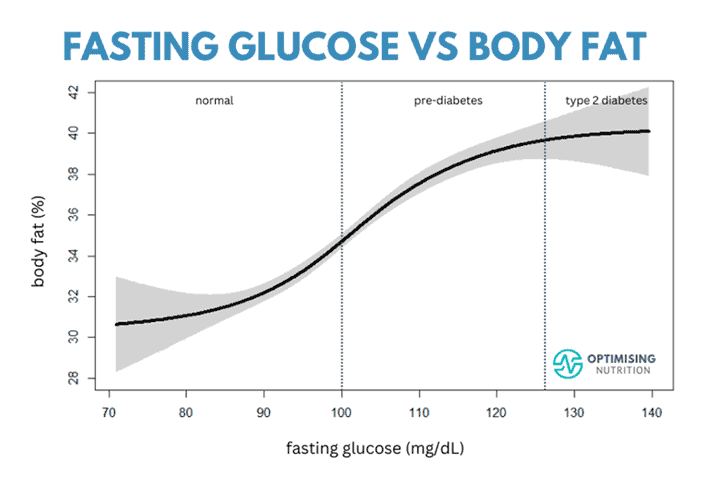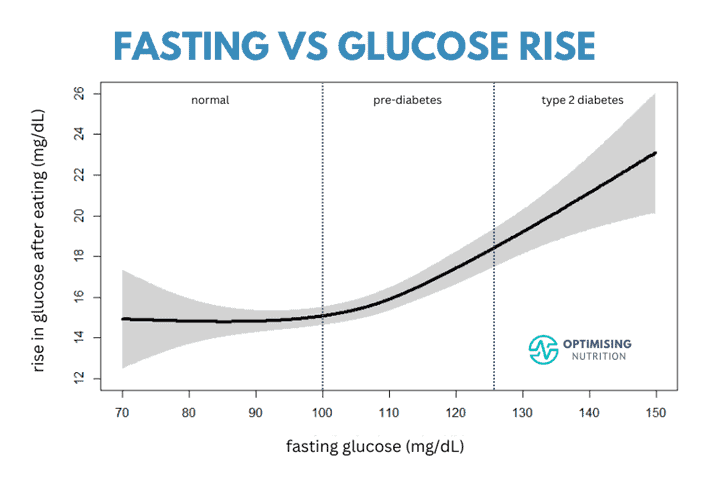Many people wonder if Type 2 Diabetes is reversible.
Good news! As you’ll learn in this article, many can reverse their type 2 diabetes, especially if they catch it early.
Previously, we looked at long-term weight loss trajectories for people who have lost a lot of weight with Data-Driven Fasting.
While we often focus on weight, our fasting glucose is an important marker of our overall metabolic health, showing us what is happening inside our body.
In this article, we’ll look at the long-term trends in people who have started with fasting glucose in the Type 2 Diabetes range (i.e. above 126 mg/dL or 7.0 mmol/L).
As you’ll see, every chart has a unique story to tell.
If you’ve been diagnosed with Type 2 diabetes, the examples in this article will give you a deeper understanding of what it takes to gain control of your metabolic health and some inspiration for what is possible.
Carol
Carol joined us for her first round of the Data-Driven Fasting Challenge in May 2021 and continued with our masterclasses as part of our All-Inclusive Membership.
Fasting Glucose
Carol’s chart below shows that her fasting glucose started well above the cut-off for Type 2 Diabetes but fell quickly after a couple of successive rounds of Data-Driven Fasting.
Note: Our Optimisers track their progress during the Data-Driven Fasting Challenges in the DDF app, which guides them on when and what to eat. To create the charts in this article, I’ve downloaded all the data for review and plotted the data for each user in Excel.
Weight
After starting at 213 lbs (97 kg), Carol’s weight dropped quickly, in line with her initial drop in fasting glucose (as shown in the chart above).

Her weight then stabilised for a while before she made another push for further weight loss between November 2022 and May 2023.
Premeal Glucose
This chart shows Carol’s premeal glucose, falling quickly initially and then stabilising at a healthy level that her body was comfortable with.

Our bodies like to maintain a healthy glucose level in our system, so it doesn’t let your glucose drop too low. Data-Driven Fasting builds on the understanding that once we lower our blood glucose a little below what is normal for us, our bodies can get on with using the stored energy in the other fuel tanks in our body.
Body Fat
But once the excess glucose is cleared, your body can access your stored body fat. Carol’s body fat dropped from 35% to a healthy 23%. She also lost five inches (16 cm) off her waist in the process!
Katie
Katie initially joined us for Data-Driven Fasting but also jumped into our Nutritional Optimisation Masterclass, the predecessor to our Macros and Micros Masterclasses.
Fasting Glucose
The chart below shows her fasting glucose trajectory starting well above the cut-off for Type 2 Diabetes. But as she continued with DDF and the masterclasses, her fasting glucose dropped, eventually into the normal healthy range, below 100 mg/dL.
Weight
This next chart shows Katie’s weight during this time. Notice how the biggest improvements in her fasting glucose coincide with the period of weight loss with DDF between October 2021 and April 2022.
Premeal Glucose
The next chart shows Katie’s premeal glucose levels during this time. Interestingly, premeal glucose must often drop to healthier levels before the weight and body fat come off. Again, once we clear the excess glucose, your body can access the stored fat.
As she chased a lower personalised glucose trigger, Katie’s premeal glucose fell consistently between December 2020 and May 2021. Once she cleared the excess glucose from her system, the weight started coming off in October 2021.
Body Fat
Katie’s body fat followed along with her weight, falling from a high of 45% to a very healthy 26% once she got her premeal glucose down into a healthier range. Katie also lost ten inches (26 cm) from her waist!
Carolyn
Carolyn initially joined us for Data-Driven Fasting and then jumped into our All-Inclusive Membership to continue with our Macros Masterclass and Micros Masterclass.
Fasting Glucose
As you can see in the chart below, Carolyn’s fasting glucose started out extremely high but continued to fall as the weight started to come off.
While her fasting glucose is not yet in the normal healthy range, she’s made massive improvements!
Weight
With successive challenges over the years, Carolyn has made great progress with her weight loss, with an overall weight loss of 28 lbs (13 kg).
Premeal Glucose
Carolyn’s premeal glucose has continued to fall. I’m looking forward to seeing where it lands in the long term.
Reflections
Each person has a unique trajectory that depends on where they start out and their level of consistency and focus. I’ve reviewed hundreds of charts recently to understand people’s success factors and trends from those using our Data-Driven Fasting app.
Lowering Your Fasting Glucose is a Long-Term Game
Many people in the Data-Driven Fasting Challenges ask how they can lower their waking glucose levels.
While there are some short-term ‘hacks’ that can make a small difference, the reality is that lowering your fasting glucose and reversing Type 2 Diabetes is a long-term game.
The chart below shows that fasting glucose is tightly correlated with weight, BMI and body fat.
As you deplete the stored energy in your body, there will be less excess energy to ‘back up’ into your bloodstream overnight.
However, while we may feel powerless to lower our fasting glucose, the good news is that we can control our premeal glucose by managing when and what we eat. As shown in the chart below, the glucose BEFORE we eat is very tightly correlated with our fasting glucose.
Of all the things we can track in the DDF app, it’s the premeal glucose that has the strongest correlation with fasting glucose, by far!
By ensuring our glucose is just below what is normal for us, we ensure that we are tapping into our stored glucose and body fat each time before we eat. As we chase a lower premeal glucose, the weight comes off, and eventually, fasting glucose falls into a healthier range.
Reducing Carbohydrates Only Manages One of the Symptoms
As shown in the chart below, people with higher fasting glucose also see a larger rise in glucose after they eat.
Many people who follow a lower-carb diet still have an elevated fasting glucose level despite consuming less carbohydrates. Reducing the carbohydrates in your diet can help to stabilise your glucose. But unless your dietary changes reduce your weight and fasting glucose, they’re not addressing the root cause of type 2 diabetes.
Medications Only Manage the Symptoms
Medications, like exogenous insulin, also help to manage the symptoms of type 2 diabetes by supplementing the insulin produced by the pancreas. But, exogenous inulin merely enables the body to hold its excess energy in storage.
Unfortunately, exogenous insulin also enables us to gain more weight. Hence, it’s ideal to act early to address the root cause of type 2 diabetes, well before you require medications to manage the condition. But the good news is that it’s (usually) not too late to start addressing the root cause.
Reversing Type 2 Diabetes is Possible, Especially if You Catch it Early
Professor Roy Taylor’s Counterbalance Study showed that 87% of people who had received a diagnosis of type 2 diabetes within four years were able to reverse their Type 2 Diabetes with significant weight loss. However, unfortunately, only 50% of those who had been diagnosed with type 2 diabetes for more than four years saw diabetes reversal with significant weight loss.
Taylor’s work shows that once we deplete the fat around our vital organs (e.g., the liver and pancreas), pancreatic function can often be fully restored. Because there is less energy to hold in storage, the pancreas also gets a break because it doesn’t need to produce as much insulin.
However, unfortunately, if diabetes has progressed for long enough, people can experience pancreatic burnout (i.e. beta cell failure), which makes it less likely that full pancreatic function will be restored. This condition is sometimes known as ‘double diabetes’, where someone loses pancreatic function and is extremely insulin resistant due to excessive amounts of stored fat.
Type 2 Diabetes is not something that happens overnight. It creeps up on us over time with insidious, progressive weight creep. The good news is that we can take control of it before it becomes irreversible.
The chart below shows the distribution of fasting glucose levels recorded in the DDF app. Toward the right, we see that about 9% of our Optimisers have a fasting glucose that would technically be classified as in the Type 2 Diabetes range. However, more than half of our Optimisers have a fasting glucose that puts them in the prediabetes range (i.e. fasting glucose greater than 100 mg/dL or 5.6 mmol/L).
Fasting Alone Isn’t Enough
Unfortunately, as I’ve examined the data, I’ve seen charts from many people who have lost weight rapidly with Data-Driven Fasting, only to regain it later.
While it might seem logical that fasting is the best way to lose weight, fasting alone, even Data-Driven Fasting, won’t ensure you keep the weight off, especially if you return to eating as you used to.
In addition to losing weight, you also need to address the lifestyle factors that caused the problem in the first place.
What you eat is critical to the weight loss and maintenance equation. We can use our willpower and self-discipline to eat less for a while, but eventually, we all eat to satiety.
As well as managing when you eat, what you eat part of the equation is critical. Your body needs adequate protein, minerals, and vitamins to feel safe and thrive long-term.
It’s usually the people who improve what they eat, with our free food list and NutriBooster recipes, as well as the Macros Masterclass and Micros Masterclass, that make the best long-term progress and keep the weight off!
Summary
- Many people have used Data-Driven Fasting to significantly improve their fasting glucose levels, even if they start out in the Type 2 Diabetes range.
- Once our bodies clear the excess glucose in our system, they can access the excess stored body fat.
- While fasting glucose is hard to control, we can actively manage our glucose before we eat.
- Long-term maintenance requires long-term changes to daily food habits, focusing on nutrient density and higher satiety foods.
Action Steps
- To learn more about Data-Driven Fasting and access the DDF App, we’d love to take our DDF 101 Course.
- To get more help and support on your DDF journey, you can join our next Data Driven-Fasting Challenge.
More
- Success Stories and Secrets of the DDF Biggest Losers
- Blood Glucose and Hunger: Decoding the Intimate Relationship
- Use Your Blood Glucose as a Fuel Gauge to Lose Weight and Optimise Your Metabolic Health
- The Powerful Premeal Blood Glucose: The Unsung Hero of Optimising Your Weight and Metabolic Health
- Try the DDF app
- Data-Driven Fasting Challenge



















